Pupping has begun
Pupping season is here: Give pups space: Disturbance is damaging: Think seal and put pups first!
This year has flown and our pupping seasons are starting earlier than they used to, likely a result of climate change affecting prey availability and sea conditions. This means we are still enjoying our peak holiday coastal activities, leaving seal mums even fewer sites to pup on. Extreme weather events are getting more frequent and like Storm Arwen last year and Storm Alec the year before, a single storm can wash away all the seal pups from their mothers leading to mass mortality events.
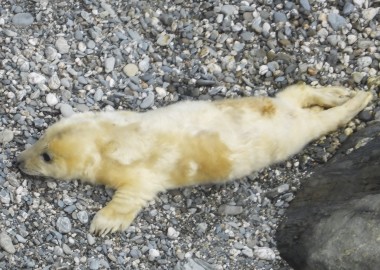
A day old seal pup
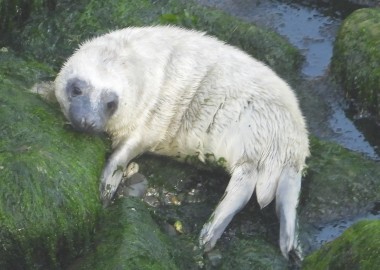
Week old seal pup started to moult
How can you help seal pups?
The key thing is to avoid telling everyone the name of the site (especially online) where you saw the pup. This just drives up visitor numbers and increases disturbance levels. Wait until the mum and pup have both left before telling others and avoid sharing photos that give away the location (please crop out cliff or beach footprints if you need to.) Please email [email protected] to tell us what you have seen.
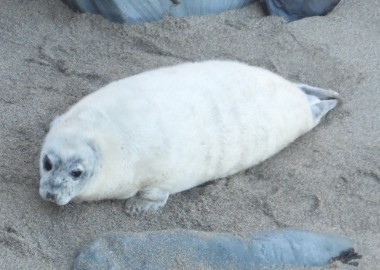
A 3 week old fat barrel over 40kg
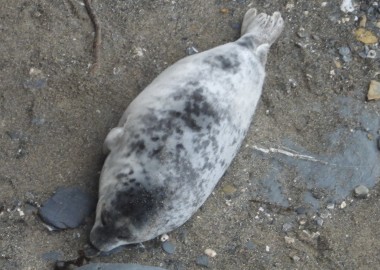
A fully moulted 3 week pup
If seal pups are not this fat, they have little chance of surviving their first winter. At first they must live off their fat reserves as they teach themselves to feed – what to eat and how to catch it!
Our impacts on mums and pups are both invisible and delayed.
Seal pups only get fed for up to 3 short weeks by their mothers. Pups must grow from 10 to 40kg to stand any chance of making it to the age of 1! During this time they also moult (lose) their long white fur pushed off by their new grey grown up coat.
Every feed is critical, being about 1% of a pup’s entire nutrition. So, it only takes a few missed feeds for a pup’s chance of survival to be reduced from slim to none.
Disturbance leads to underweight pups which likely die in the winter before they teach themselves to feed. In a good year 40% of pups will die and in a bad year, 85% won’t make it.
Disturbance can also lead to underweight mums who risk starvation because of using more energy than needed whilst fasting through lactation.
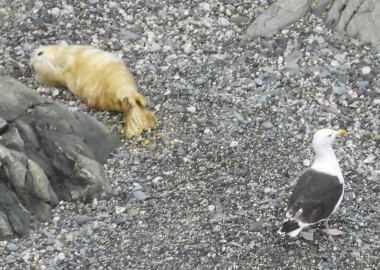
Without their mums seal pups are very vulnerable
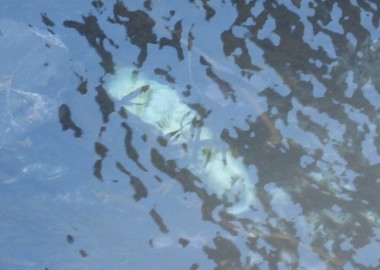
One of the pups that didn’t make it :O(
So, if you see a pup, please put them first!
Please follow advice on signs/fencing or from volunteers. Keep off the beach and well away to avoid being smelt/seen or heard by a pup and its mum. NEVER put a seal pup back in the sea.
Watch onshore/offshore for pup/mum for 30 minutes and ring BDMLR 01825 765546 if you are concerned (please put this number in your PHONE). BDMLR will send a trained Marine Mammal Medic to ASSESS the pup’s situation and condition before deciding on the best course of action.
Help us support seal pups everywhere
Why not commemorate your privileged experience of seeing a wild seal pup by treating yourself to a Seal Pup Artwork made from plastic removed from Portreath beach by Michelle Costello from Smartie Lids on the Beach. Add our tiny, unique to CSGRT, pin badges designed from photos taken by our founder Sue Sayer
OR delight a child with the story of a seal pup only getting to spend 3 weeks with its mum and at the same time changing from a white to a grey coat with one of our brand new Transformer seals
Please follow the link to our shop in the menu at the top of the page
#Donotdisturb #Keepyourdistance #Useyourzoom #Givesealsspace #Respectthenap #Sealsmile #OpSeabirdSW #CSGRTDisturbance #Rudetointrude
